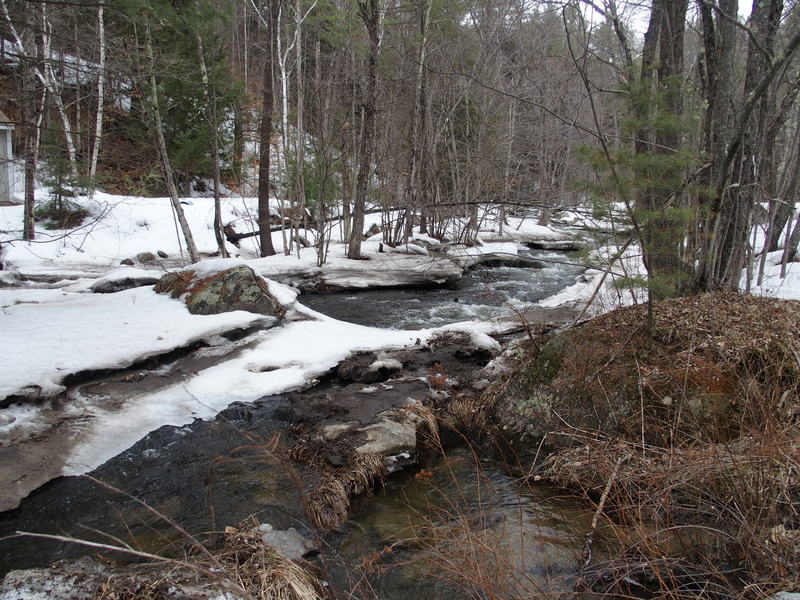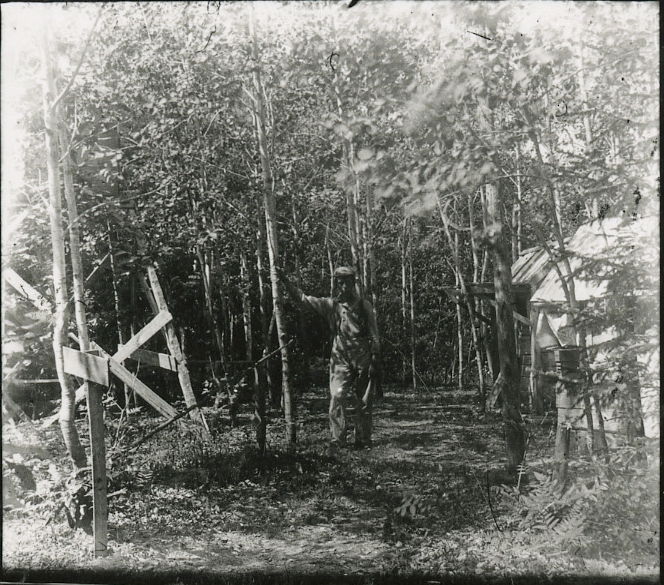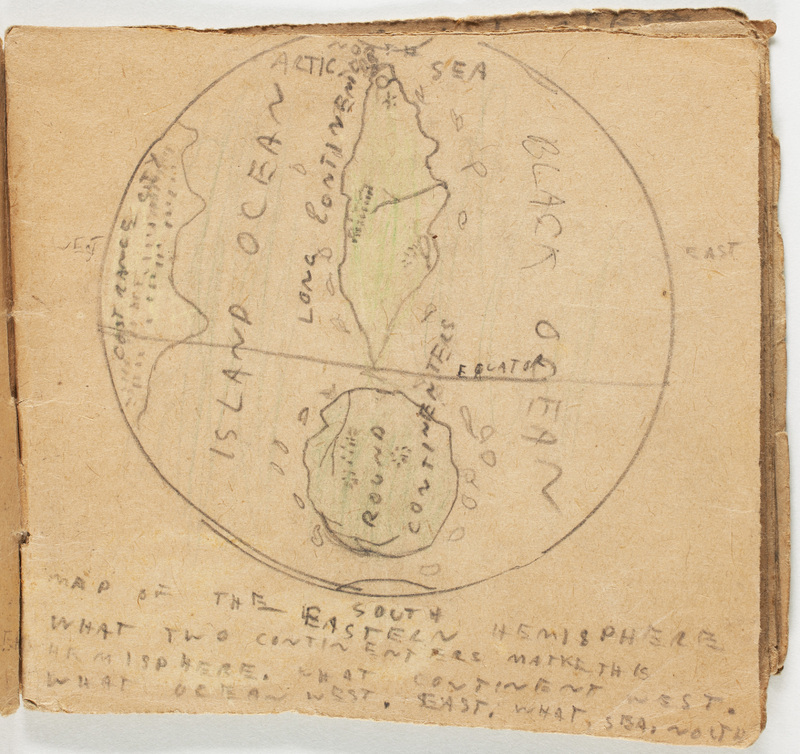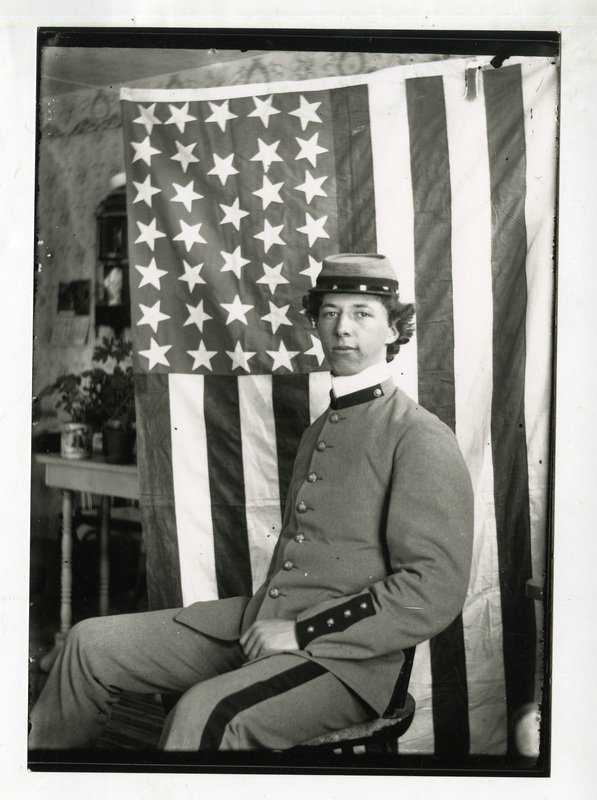Play
The young brothers ventured into their surrounding landscape when it was time to play. Their individual and collective experiences provided them with plenty of material to incorporate into their realistic and imaginary works. Walter Nelson discusses the boys unique style of play in Sketches of Our Home Life Vol. 1 and recalls, “While we were living at Mill Village our play-grounds vacillated between the pasture, brook and ‘islands’, from playing Indian, and naval engagements to war—‘as the fit took us’”(p. 10). The Nelson brothers’ bookmaking was certainly one form of play, but it was in the fields and brooks where the boys’ imaginations were unleashed.

A view of the snow-covered brook that runs beside the Nelson's old home with "Round Continent" in the foreground and "Long Continent" behind (2014)
The Nelson brothers created a world of their own in the brook that ran beside their home. The brook served as a natural playground for the boys to interact with both mentally and physically. Walter describes the islands that the boys played on and notes, “Each of us owned a small island in the brook on which we built houses and miniture fortifications and had battles which Arthur (the worlds historian) made very stirring with accounts of spirited charges and valiant repulses; he also made maps of the islands which we had named Big, Long and Round Continent's and peopled them with millions of imaginary inhabitants about which we wrote many stories”(Sketches of Our Home Life, Vol. 1. p.11). The most amazing part about the Nelson brothers’ creativity was their ability to work diligently to create a cohesive history of their imaginary world and its characters. Arthur, Walter, and Elmer even created alter egos for themselves--William Little, Eathan Allen, and Burt Green respectively--to rule each of the continents. The boys were remembering both realistic and imaginary happenings after playing each day, developing a historical account of their experiences, and then building on previously recorded events when they returned to the outdoors. The Nelson brothers defined an original form of play as a result of their 19th century upbringing in rural New Hampshire, but were not the only children to craft books and write their own stories at a young age (See Paracosms)—though the number of items preserved in their collection is rare.
Even when the Nelson family moved from their Mill Village home to the Gunnison House, the brothers continued to manipulate their surrounding landscape and develop a world of their own—one that they were, again, in complete control of. Walter notes that,“It was with much regret that in the Winter of 1891 we moved away from the islands, up into the Center district, but before long we discovered a steep bank above the brook which well filled the place of the islands and we at once set about improving it” (Sketches of Our Home Life, Vol. 1, p.11). It is impossible to place an exact date on each story or book the boys created, but it is clear that they continued developing works that narrated their playful experiences after they had moved homes and continued to grow up between the ages of six and twelve.
The stories that the boys produced dealt with many themes, including one of their favorites—playing Indian. Walter recalls this imaginative form of play as “the most exciting game [the brothers] played in those days. He continued, “I hardly believe I should yell louder if I should see a genuine, wild-Indian than I did then. The last year or two, that we lived there we had a platform in a great spruce for the white-man's fort and our stratagems, surprises, and pitched-battles were blood-curdling in their intense reality and the neighbors said that we could be heard half-a-mile away as some body was being scalped by the wooden tomahawks or getting killed from ambush in the alders with milk-weed spears” (Sketches of Our Home Life, Vol. 1, p.10). Entering the imaginary world of the brothers is an invigorating experience. The books they wrote about their imaginary "World" provide outsiders with a chance to understand the depths of the Nelson brothers’ redefinition of the word “play.”

A glass plate negative photograph labeled "Poplington," a settlement within the boys' imaginary world.
In The Young Sailor or Deer Lake, the ways that the boys' real world play shapes the adventures of their imaginary world is particularly clear. In this book the boys write about a “play” battle where they used stones and sticks as weapons, not rifles or cannons: “he had got out of range hurried back into the shelter of the woods for several of them had got brushed by stones and sticks Ethan again came up this time the boys only tried to throw stones to where he was.” The battle was held between the Berryville boys and the Deerlake boys, "school" rivals that competed with each other.
Since the Deerlake boys beat the Berryville boys, they decided to have a celebratory picnic. They picked a day for the picnic and it was held on the most pleasant of summer days. It is fitting that the picnic was held in the depths of the children's natural playground.
“The children went boys and girls all off to the woods too a frolic and picnic each one had a small basket in which was packed all the goodies from their mothers pantry. The place to which they went was a small open space in the midst of and oak and maple woods, in this place the boys had put up some rough seats and a table the day before, all the lunch baskets were put on the table then the boys and girls went around in the woods after flowers and played tag and other games in the clearing.”
Chap 3. “The Battle Ended. A Picnic”
The picnic concludes with choosing the king and queen of the woods. The story ends noting that “Ethan was nominated as the king and everyone voted for him. Then Jessie Thornwood was chosen queen.” Might this be a girl that one of the young brothers was fond of? In anycase fighting battles, playing tag, having picnics, and making books are all pleasurable games for these boys and girls.
There is no doubt that the Nelson brothers' creation of an in-depth imaginary society served as a means of education. Similar to the Nelson brothers, a group of creative children imagined a community within a sand pile in their back yard in G. Stanley Hall’s The Story of a Sand-Pile. Hall’s story highlights the children’s engagement in problem solving, architecture, and mindfulness—all while having fun. There are striking similarities to the Nelson brothers’ continents and the imaginary community within the sand-pile. Hall notes that there were “nearly a dozen farms [that] were laid out on one main and several lesser streets, somewhat like those in town, each, perhaps, five or six feet square, with tiny rows of stone for walls and fences, with pasture and mow-lots, and fields planted with real beans, wheat, oats, and corn, which is topped before it has spindled, and with a vase or box for a flower garden”(Hall, p. 5). The children even created “a tiny newspaper, some three inches square, devoted entirely to the affairs of the “sand-pile” was started, with seven subscribers. At a dollar per month in their peculiar currency, but the labor of duplicating soon caused its abandonment”(Hall, p. 10). Sounds quite similar to some of the periodicals produced by the Nelson brothers!
As mentioned before, the Nelson brothers were not the only children engaging in outdoor play in the 19th century, but The Story of a Sand-Pile shows how lucky we are to have preserved the history of the Nelson brothers’ childhood. At the end of the story, Hall notes that once the “boys reach the age of fourteen, more or less, the ‘sand-pile’ gradually loses its charm, and seems childish and unreal. One member of the circle was, [he thinks], fifteen and had become quite alive to its fictitious nature”(Hall, p. 17). Similarly, the Nelson brothers grew older and became less intrigued by their homemade bookmaking and outdoor play. Once the Nelson brothers grew a bit older though, they documented their actual lives in Goshen through photography and journal entries—adding to the rich collection of their childhood artifacts.
SOURCES:
Hall, G. Stanley. The Story of a Sandpile. New York and Chicago: E. L. Kellog, 1897. Print.

